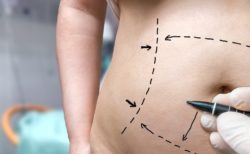When Dr. Sabbagh in Detroit, Michigan, evaluates a patient’s abdomen during consultation, the best solution between liposuction or tummy tuck depends on several factors. The primary factor in deciding between liposuction and tummy tuck is the quality of the skin.
If the patient has significant stretch marks and looseness or hanging skin of the lower abdomen and the pubic region, an abdominoplasty or tummy tuck is a better approach. The abdominoplasty allows the skin to be elevated off of the muscles, and the underlying muscles are tightened. This method provides a flatter abdomen, and also improves the core muscle strength. Excess skin can be removed, which also results in a tighter, flatter stomach appearance. The only negative aspect of a tummy tuck is the incision, which generally extends from hip to hip. There is also more downtime associated with a tummy tuck.
Liposuction of other areas of the body, especially the waist and flanks, can be performed at the same time to improve the results. Alone, liposuction is ideal for patients with good quality skin and toned underlying muscles, but extra areas of fatty deposits. Liposuction thins the layer of fat on the stomach, the skin will retract and maintain a relatively nice contour and texture. If the fat is excessive and removed, this may lead to deflation and wrinkling of the skin. The most common complication from liposuction are skin contour irregularities, most commonly of the abdomen.
It is also important to understand that all of us carry fat intra-abdominally around our intestines. As we gain weight, this fat increases, and this also causes protrusion of the abdomen. An abdominoplasty can most effectively improve this protuberance by tightening the muscles. However, there is a limit to how tight the muscle can be. Liposuction alone will not improve the protruding muscle layer.
When choosing between a liposuction and an abdominoplasty, Dr. Sabbagh will take into account the three layers of the abdomen, which includes internal muscles, the mid layer of fat, and the overlying skin.


